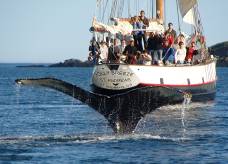Whale Watching in New Brunswick and Newfoundland & Labrador – June 2011
There is nothing more awesome than a close encounter with a whale. And along the coast of Atlantic Canada, there are whales galore from June to October. The picturesque provinces of New Brunswick and Newfoundland & Labrador offer some of the world’s best whale watching opportunities and, after a mere five-hour flight, travelers can head off ready to take to the high seas.
Scudding through the waves off the coast of New Brunswick, a shout goes up: “Thar she blows!” Only yards from the 25-ft Zodiac, a vast grey back heaves out of the water, flips its tail and swoops back beneath the surface. Dressed in their orange survival suits, the holidaymakers all go “Aaaah!” – then click away with cameras.
 These whale watchers are in the Bay of Fundy, which is like a great big supermarket for a dozen species of whales. A finalist in the New7Wonders of Nature global campaign, the home of the world’s highest tides provides finbacks and humpbacks, minkes and the endangered right whales with mackerel, herring, pollock and squid for breakfast, lunch and dinner. Among the rarest whales in the world, with only 350 left, some right whales actually mate in the Bay of Fundy. Second only to blue whales in size are the finbacks, all of 80 tons and 80 feet long.
These whale watchers are in the Bay of Fundy, which is like a great big supermarket for a dozen species of whales. A finalist in the New7Wonders of Nature global campaign, the home of the world’s highest tides provides finbacks and humpbacks, minkes and the endangered right whales with mackerel, herring, pollock and squid for breakfast, lunch and dinner. Among the rarest whales in the world, with only 350 left, some right whales actually mate in the Bay of Fundy. Second only to blue whales in size are the finbacks, all of 80 tons and 80 feet long.
Although some visitors enjoy the high-speed thrill of a Zodiac, you can also head out aboard a cruiser or even a stately sailing ship from coastal ports, such as St Andrew’s by the Sea, Campobello Island and Grand Manan Island.
Food also attracts whales further north, off Newfoundland & Labrador, where the Gulf Stream and the Labrador Current meet over the Grand Banks, known for its abundant cod for 500 years. Here, the whales come so close to land that visitors can actually spot them blowing from the shore! In all, you can see some 22 species of whales, porpoise and dolphins here, including the rare narwhal and the blue pigmy whale.
 A great place to see them is in the Witless Bay Ecological Reserve, only half an hour south of St John’s, Newfoundland. There is nowhere better for getting up close and personal with Mother Nature. As well as the whales, there are zillions of puffins on the rocky islets. Up around St Anthony, a port in northern Newfoundland, it’s not unusual to see mysterious greeny-blue icebergs floating past (heading south) and whales (swimming north) at the same time.
A great place to see them is in the Witless Bay Ecological Reserve, only half an hour south of St John’s, Newfoundland. There is nowhere better for getting up close and personal with Mother Nature. As well as the whales, there are zillions of puffins on the rocky islets. Up around St Anthony, a port in northern Newfoundland, it’s not unusual to see mysterious greeny-blue icebergs floating past (heading south) and whales (swimming north) at the same time.
Off the Labrador coast, a renowned whale watching spot is Battle Harbour, where wildlife enthusiasts come to see the pods of black and white orca whales (also known as killer whales) that return to the waters off this preserved historic village every year.
Visitors from around the world come to see and photograph whales. For many, it is a thrill of a lifetime. Although skippers try to provide that experience, their first priority is the whales. That’s why all Atlantic Canada’s whale watching companies have signed up to a special code of conduct, promising that they will never harass these gentle giants.
TIPS:
- When at sea, be prepared. Take layers; put them on or take them off to avoid being too hot or too cold. Take seasick pills, spare batteries for your camera.
- A good time to see whales is after heavy rain; rain stirs up the bait fish that whales feed on!
Bridge & Wickers (www.bridgeandwickers.co.uk), 020 7483 6555) have a 14 night self drive from £2257 per person including international flights with Air Canada, 15 days car hire, 14 nights accommodation, ferry crossings from Digby to St John and North Sydney to Port Aux Basques, whale watching at Grand Manan and Bay Bulls. Note: This package includes discounted flights and needs to be booked by 15th of July.